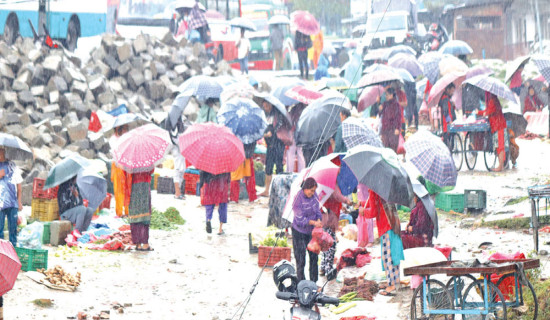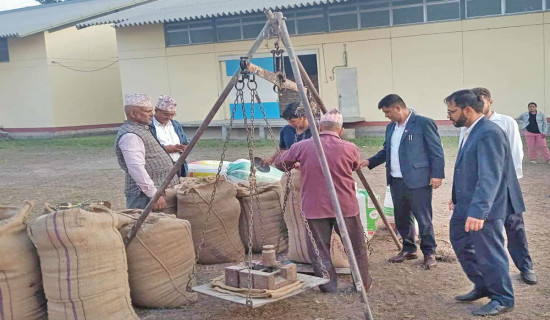- Sunday, 9 November 2025
Nepal spending over Rs. 2 billion annually to import chillies
Kathmandu, June 13: Believe it or not, people of an agrarian country like Nepal consume imported chillies worth more than Rs. 2 billion a year. But statistics of Department of Customs confirm this truism.
Statistics show that Nepal spends more than Rs. 2 billion to import chilli annually where more than 65 per cent of the people engage in agriculture.
According to the latest data from the Department of Customs, the country imported 7,574 tonnes of chilli, worth Rs. 1.93 billion, in the first 10 months of the current fiscal year alone.
Although chilies can be produced locally, the country has been spending a whopping amount to import a tiny kitchen item like chilli. And this arrives in our kitchen from India, China, Pakistan, Romania, South Korea, Japan, Denmark, Namibia, and Hong Kong. However, the biggest amount is imported from India. Of Rs. 1.93 billion spent to import chilli during the first 10 months of the current fiscal year, India’s share was Rs. 1.92 billion.
Approximately 7,569 tonnes of chilli was imported from India while 3,600 kgs dried chillies worth Rs. 2.05 million was brought from South Korea.
The country imported 1,638 kg of chillies worth Rs. 390,000 from China, 95 kg worth Rs. 73,000 from Japan, and 10 kg worth Rs. 29,000 from Romania.
Similarly, in the first 10 months of the current fiscal year, approximately 2 kg of chillies was imported from Namibia and one kg each from Denmark and Hong Kong.
The government has collected revenue of Rs. 467 million from chilli imports during the first 10 months of the current fiscal year.
The country imported 7,929 tonnes of chilli worth Rs. 2 billion during the first 10 months of the last fiscal year 2023/24.
Likewise, around 9,217 tonnes of chilli worth Rs. 2.31 billion was imported in the last fiscal year.
In the meantime, the country exported only 233 kgs of chilli worth Rs. 487,000 during the first 10 months of the current fiscal year.
Why dependence on imports?
Experts said that with proper investment in local chilli production and processing, Nepal could significantly reduce its import burden while boosting rural employment and enhancing food self-sufficiency. “It’s a serious concern for both the government and the general public that an agricultural country is heavily dependent on imported chillies, which could be easily grown at home or on farms,” Joint Secretary of the Ministry of Agriculture and Livestock Development Dr. Hari Bahadur K.C.
He said that increasing chilli imports, which can meet domestic demand by planting two or three chili plants in vegetable gardens and pots, is a challenge for an agricultural country.
The contribution of the agriculture sector to the GDP is estimated to be 25.61 per cent in the current fiscal year.
"We, Nepali citizens should help reduce imports by planting chilies in our vegetable gardens for domestic consumption and farmers should focus on commercial production of chilies," he said.However, in recent times, farmers in various districts of the country have been cultivating other varieties of chilies, including Akbare, he said.
Farmers prefer to sell green chillies rather than dried ones
Bhagwan Chandra Upreti, a trader at the Kalimati Fruit and Vegetable Market Development Board, said that Nepalis farmers sell green chillies as they are more profitable than selling dried chillies.
"It takes about 6 kilograms of green chillies to produce 1 kilogram of dried chillies, and there is lack of drying machines as well. So, farmers are not shown their interest for the production of dried chillies. If the local government provides drying machines and attracts people to dry chilli production by providing subsidies, billions of rupees will be saved from being exported abroad."
He said that farmers in Nepal are currently selling green chillies for around Rs. 40-50 per kg, while the price of dried chillies is around Rs. 300 per kg.
In this context, why do farmers take the challenge of producing dried chillies if they are already earning by selling green chillies at the same rate as dried chillies?
In contrast, Indian farmers benefit from higher yields and government subsidies, making dried chilli production more viable and competitive, he said.
Upreti urged the government of Nepal to offer similar incentives and support, such as subsidies, quality seeds, and post-harvest infrastructure.
Joint Secretary K.C said that the government has been promoting the production of vegetables, including chilli through zone and super zone under the Prime Minister Agriculture Modenisation Project.
He said that the local government should also pay attention for expanding the area of chilli cultivation by encouraging farmers.
The statistics of National Center for Potato, Vegetable and Spice Crops Development showed that the production of dried chilling has been growing in the country over the past few years.
Around 86,992 tonnes of chilli was produced while cultivating in around 11,349 hectares of land in the fiscal year 2022/23.
Similarly, around 83,898 tonnes of chilli was produced in the fiscal year 2021/22 and around 87,731 tonnes in the fiscal year 2020/21. Only 68,025 tonnes of chilli produced in the fiscal year 2019/20.
















